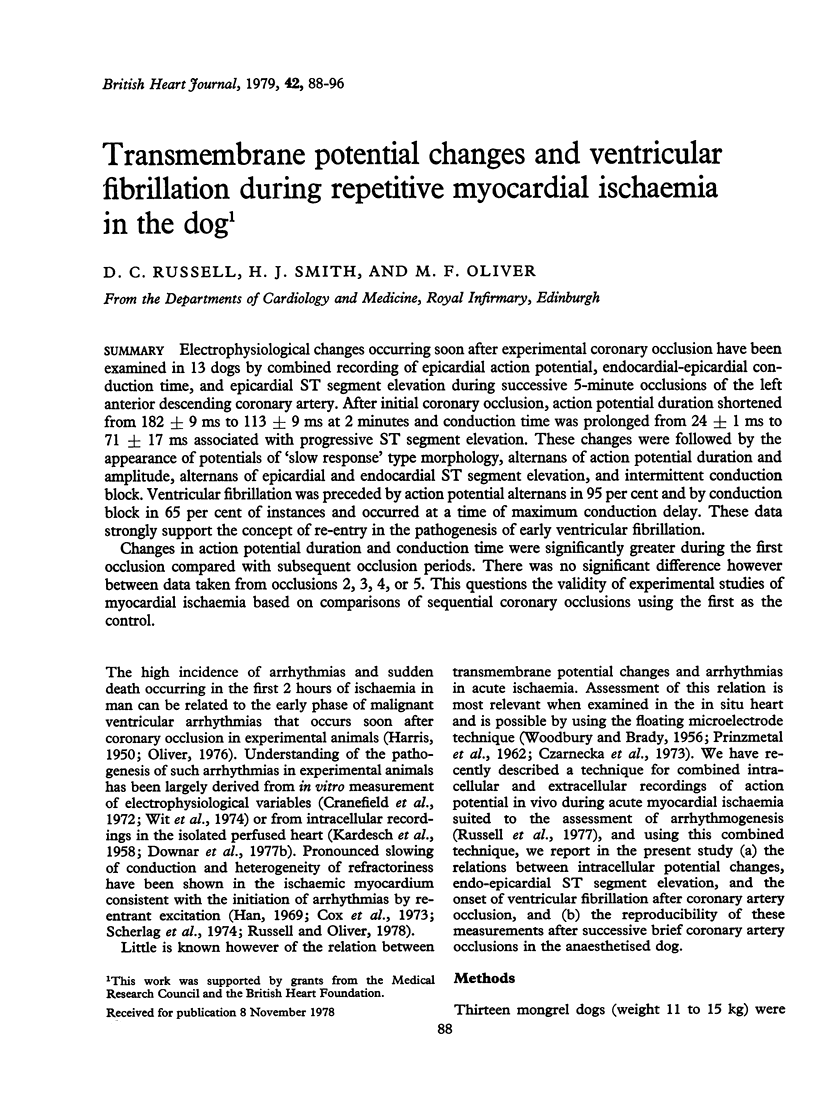Full text
PDF








Selected References
These references are in PubMed. This may not be the complete list of references from this article.
- Berne R. M., Rubio R. Acute coronary occlusion: early changes that induce coronary dilatation and the development of collateral circulation. Am J Cardiol. 1969 Dec;24(6):776–781. doi: 10.1016/0002-9149(69)90466-4. [DOI] [PubMed] [Google Scholar]
- Cox J. L., Daniel T. M., Boineau J. P. The electrophysiologic time-course of acute myocardial ischemia and the effects of early coronary artery reperfusion. Circulation. 1973 Nov;48(5):971–983. doi: 10.1161/01.cir.48.5.971. [DOI] [PubMed] [Google Scholar]
- Cranefield P. F., Wit A. L., Hoffman B. F. Conduction of the cardiac impulse. 3. Characteristics of very slow conduction. J Gen Physiol. 1972 Feb;59(2):227–246. doi: 10.1085/jgp.59.2.227. [DOI] [PMC free article] [PubMed] [Google Scholar]
- Czarnecka M., Lewartowski B., Prokopczuk A. Intracellular recording from the in situ working dog heart in physiological conditions and during acute ischemia and fibrillation. Acta Physiol Pol. 1973;24(2):331–337. [PubMed] [Google Scholar]
- Downar E., Janse M. J., Durrer D. The effect of "ischemic" blood on transmembrane potentials of normal porcine ventricular myocardium. Circulation. 1977 Mar;55(3):455–462. doi: 10.1161/01.cir.55.3.455. [DOI] [PubMed] [Google Scholar]
- Downar E., Janse M. J., Durrer D. The effect of acute coronary artery occlusion on subepicardial transmembrane potentials in the intact porcine heart. Circulation. 1977 Aug;56(2):217–224. doi: 10.1161/01.cir.56.2.217. [DOI] [PubMed] [Google Scholar]
- Durrer D., Van Dam R. T., Freud G. E., Janse M. J. Re-entry and ventricular arrhythmias in local ischemia and infarction of the intact dog heart. Proc K Ned Akad Wet C. 1971;74(4):321–334. [PubMed] [Google Scholar]
- El-Sherif N., Scherlag B. J., Lazzara R., Hope R. R. Re-entrant ventricular arrhythmias in the late myocardial infarction period. 1. Conduction characteristics in the infarction zone. Circulation. 1977 May;55(5):686–702. doi: 10.1161/01.cir.55.5.686. [DOI] [PubMed] [Google Scholar]
- Elharrar V., Foster P. R., Jirak T. L., Gaum W. E., Zipes D. P. Alterations in canine myocardial excitability during ischemia. Circ Res. 1977 Jan;40(1):98–105. doi: 10.1161/01.res.40.1.98. [DOI] [PubMed] [Google Scholar]
- Friedman P. L., Fenoglio J. J., Wit A. L. Time course for reversal of electrophysiological and ultrastructural abnormalities in subendocardial Purkinje fibers surviving extensive myocardial infarction in dogs. Circ Res. 1975 Jan;36(1):127–144. doi: 10.1161/01.res.36.1.127. [DOI] [PubMed] [Google Scholar]
- HARRIS A. S. Delayed development of ventricular ectopic rhythms following experimental coronary occlusion. Circulation. 1950 Jun;1(6):1318–1328. doi: 10.1161/01.cir.1.6.1318. [DOI] [PubMed] [Google Scholar]
- HELLERSTEIN H. K., LIEBOW I. M. Electrical alternation in experimental coronary artery occlusion. Am J Physiol. 1950 Feb;160(2):366–374. doi: 10.1152/ajplegacy.1950.160.2.366. [DOI] [PubMed] [Google Scholar]
- Han J. Mechanisms of ventricular arrhythmias associated with myocardial infarction. Am J Cardiol. 1969 Dec;24(6):800–813. doi: 10.1016/0002-9149(69)90469-x. [DOI] [PubMed] [Google Scholar]
- KARDESCH M., HOGANCAMP C. E., BING R. J. The effect of complete ischemia on the intracellular electrical activity of the whole mammalian heart. Circ Res. 1958 Nov;6(6):715–720. doi: 10.1161/01.res.6.6.715. [DOI] [PubMed] [Google Scholar]
- Kent K. M., Smith E. R., Redwood D. R., Epstein S. E. Electrical stability of acutely ischemic myocardium. Influences of heart rate and vagal stimulation. Circulation. 1973 Feb;47(2):291–298. doi: 10.1161/01.cir.47.2.291. [DOI] [PubMed] [Google Scholar]
- Kleinfeld M., Stein E. Electrical alternans of compenents of action potential. Am Heart J. 1968 Apr;75(4):528–530. doi: 10.1016/0002-8703(68)90010-0. [DOI] [PubMed] [Google Scholar]
- Kléber A. G., Janse M. J., van Capelle F. J., Durrer D. Mechanism and time course of S-T and T-Q segment changes during acute regional myocardial ischemia in the pig heart determined by extracellular and intracellular recordings. Circ Res. 1978 May;42(5):603–613. doi: 10.1161/01.res.42.5.603. [DOI] [PubMed] [Google Scholar]
- Luxton M. R., Russell D. C., Murray A., Williamson D., Neilson J. M., Oliver M. F. Praecordial ST segment elevation. New technique for continuous recording and analysis. Br Heart J. 1977 May;39(5):493–501. doi: 10.1136/hrt.39.5.493. [DOI] [PMC free article] [PubMed] [Google Scholar]
- McDonald T. F., MacLeod D. P. Metabolism and the electrical activity of anoxic ventricular muscle. J Physiol. 1973 Mar;229(3):559–582. doi: 10.1113/jphysiol.1973.sp010154. [DOI] [PMC free article] [PubMed] [Google Scholar]
- PRINZMETAL M., TOYOSHIMA H., EKMEKCI A., NAGAYA T. Angina pectoris. VI. The nature of ST segment elevation and other ECG changes in acute severe myocardial ischaemia. Clin Sci. 1962 Dec;23:489–514. [PubMed] [Google Scholar]
- Russell D. C., Oliver M. F. Ventricular refractoriness during acute myocardial ischaemia and its relationship to ventricular fibrillation. Cardiovasc Res. 1978 Apr;12(4):221–227. doi: 10.1093/cvr/12.4.221. [DOI] [PubMed] [Google Scholar]
- Russell D. C., Oliver M. F., Wojtczak J. Combined electrophysiological technique for assessment of the cellular basis of early ventricular arrhythmias. Lancet. 1977 Oct 1;2(8040):684–686. [PubMed] [Google Scholar]
- SAMSON W. E., SCHER A. M. Mechanism of S-T segment alteration during acute myocardial injury. Circ Res. 1960 Jul;8:780–787. doi: 10.1161/01.res.8.4.780. [DOI] [PubMed] [Google Scholar]
- Scherlag B. J., el-Sherif N., Hope R., Lazzara R. Characterization and localization of ventricular arrhythmias resulting from myocardial ischemia and infarction. Circ Res. 1974 Sep;35(3):372–383. doi: 10.1161/01.res.35.3.372. [DOI] [PubMed] [Google Scholar]
- Smith H. J., Kent K. M., Epstein S. E. Contractile damage from reperfusion after transient ischemia in the dog. J Thorac Cardiovasc Surg. 1978 Mar;75(3):452–457. [PubMed] [Google Scholar]
- TRAUTWEIN W., GOTTSTEIN U., DUDEL J. Der Aktionsstrom der Myokardfaser im Sauerstoffmangel. Pflugers Arch. 1954;260(1):40–60. doi: 10.1007/BF00363778. [DOI] [PubMed] [Google Scholar]
- WEIDMANN S. The effect of the cardiac membrane potential on the rapid availability of the sodium-carrying system. J Physiol. 1955 Jan 28;127(1):213–224. doi: 10.1113/jphysiol.1955.sp005250. [DOI] [PMC free article] [PubMed] [Google Scholar]
- WOODBURY J. W., BRADY A. J. Intracellular recording from moving tissues with a flexibly mounted ultramicroelectrode. Science. 1956 Jan 20;123(3186):100–101. doi: 10.1126/science.123.3186.100-a. [DOI] [PubMed] [Google Scholar]
- Wit A. L., Rosen M. R., Hoffman B. F. Electrophysiology and pharmacology of cardiac arrhythmias. II. Relationship of normal and abnormal electrical activity of cardiac fibers to the genesis of arrhythmias B. Re-entry. Section I. Am Heart J. 1974 Nov;88(5):664–670. doi: 10.1016/0002-8703(74)90253-1. [DOI] [PubMed] [Google Scholar]


